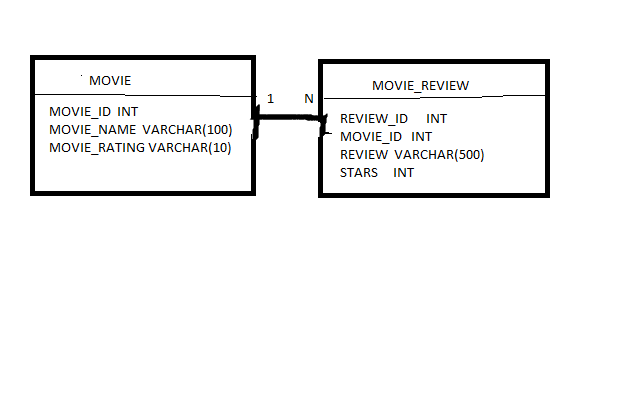Question
Using the techniques and Java JDBC APIs define a movie database application that allows a user to look up information about a movie and provide
Using the techniques and Java JDBC APIs define a movie database application that allows a user to look up information about a movie and provide a review for a movie. Your application should provide the following features:
List all movies that are rated a particular rating (PG, PG-13, R, etc) entered by the user.
All a user to post a review for a particular movie. A review consists of review text and a star rating with
5 stars = Excellent
4 stars = Good
3 stars = Neutral
2 stars = Poor
1 star = Very Poor
List all reviews for a movie and include the average star rating for the movie
Your solution should read the database connection information (jdbc driver and connection url) from a properties file called database.properties. You can create a console based application to implement this application or write a GUI interface to provide these movie database features described above. The only requirement is that the class containing the main method should be called MovieDBApp.
Here is some information about the database table schema you will be using:

A set of commands to create and populate the MOVIE and MOVIE_REVIEW tables are provided below.
CONNECT 'jdbc:derby:Lab11DB;create=true';
CREATE TABLE MOVIE (MOVIE_ID int not null primary key GENERATED ALWAYS AS IDENTITY (START WITH 1, INCREMENT BY 1), MOVIE_NAME varchar(100), RATED
varchar(10));
CREATE TABLE MOVIE_REVIEW (REVIEW_ID int not null primary key GENERATED ALWAYS AS IDENTITY (START WITH 1, INCREMENT BY 1), MOVIE_ID int, REVIEW varchar(500), STARS int);
| INSERT | INTO | MOVIE(MOVIE_NAME, | RATED) | values('Divergent', 'PG-13'); |
| INSERT | INTO | MOVIE(MOVIE_NAME, | RATED) | values('Muppets Most Wanted', 'PG'); |
| INSERT | INTO | MOVIE(MOVIE_NAME, | RATED) | values('The LEGO Movie', 'PG'); |
| INSERT | INTO | MOVIE(MOVIE_NAME, | RATED) | values('Saving Mr. Banks', 'PG-13'); |
| INSERT | INTO | MOVIE(MOVIE_NAME, | RATED) | values('Her', 'R'); |
Notice that in the CONNECT statement has a portion of the connection URL highlighted. This statement assumes that you will want to have the database files located in your program's current directory in Lab11DB. If you would like the database files to be located somewhere else on your system, you will need to update this statement. Also, when the MOVIE and MOVIE_REVIEW tables are created the MOVIE_ID and REVIEW_ID are set to be automatically generated by the database. As a result, any SQL statements to INSERT INTO the MOVIE or MOVIE_REVIEW table will not need to specify and ID. Instead, the database will automatically generate these values for you.
----------------
import java.util.Scanner; public class MovieDBApp { private static final int SELECTION_FIND_MOVIE = 1; private static final int SELECTION_WRITE_REVIEW = 2; private static final int SELECTION_VIEW_REVIEWS = 3; private static final int SELECTION_EXIT = 4; public static void main(String[] args) { Scanner in = new Scanner(System.in); int selection = getMenuSelection(in); while(selection != SELECTION_EXIT) { if(selection == SELECTION_FIND_MOVIE) { System.out.print("ENTER RATING>> "); String rating = in.nextLine(); } else if(selection == SELECTION_WRITE_REVIEW) { System.out.print("ENTER MOVIE NAME>> "); String movieName = in.nextLine(); System.out.print("ENTER NUMBER OF STARS (1 - 5)>> "); int stars = in.nextInt(); in.nextLine(); System.out.print("ENTER MOVIE REVIEW TEXT>> "); String reviewText = in.nextLine(); } else if(selection == SELECTION_VIEW_REVIEWS) { System.out.print("ENTER MOVIE NAME>> "); String movieName = in.nextLine(); } else { System.out.println("INVALID MENU OPTION"); } selection = getMenuSelection(in); } in.close(); } public static int getMenuSelection(Scanner in) { int selection = 0; System.out.println(" --- MAIN MENU ---"); System.out.println("(1) Find Movie"); System.out.println("(2) Write Review"); System.out.println("(3) View Movie Reviews"); System.out.println("(4) Exit"); System.out.print(" ENTER MENU SELECTION>> "); if(in.hasNextInt()) { selection = in.nextInt(); in.nextLine(); } else { in.nextLine(); } System.out.println(); return selection; } } MOVIE MOVIE REVIEW 1 N MOVIE ID INT MOVIE NAME VARCHAR(100) MOVIE_RATING VARCHAR(10) REVIEW ID INT MOVIE ID INT REVIEW VARCHAR(500) STARS INT MOVIE MOVIE REVIEW 1 N MOVIE ID INT MOVIE NAME VARCHAR(100) MOVIE_RATING VARCHAR(10) REVIEW ID INT MOVIE ID INT REVIEW VARCHAR(500) STARS INT
Step by Step Solution
There are 3 Steps involved in it
Step: 1

Get Instant Access to Expert-Tailored Solutions
See step-by-step solutions with expert insights and AI powered tools for academic success
Step: 2

Step: 3

Ace Your Homework with AI
Get the answers you need in no time with our AI-driven, step-by-step assistance
Get Started


